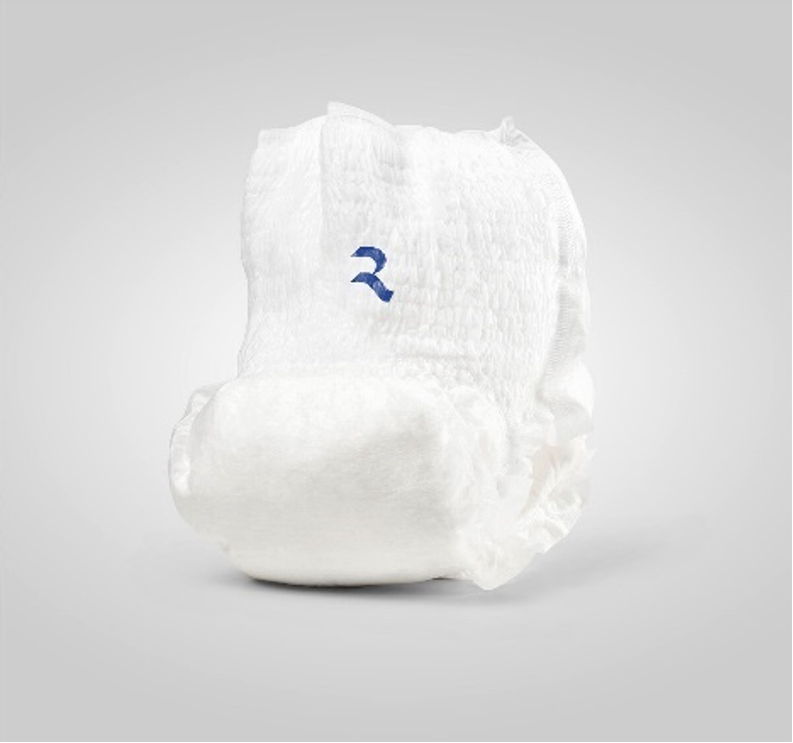
Downgauging Saving costs, producing more sustainably
Plastics are indispensable in many applications. As nonwovens, they make diapers hygienic, skin-friendly and leak-proof, and as films, they preserve food for a longer period of time. Today, plastics perform many of these important functions using far less material than ever before. For example, manufacturers have adapted their product design to avoid unnecessary volume in packaging. In many cases, however, the materials used have also become thinner and lighter, while their mechanical properties have remained the same or even improved.
In the past this so-called downgauging was mainly pursued for economic reasons, but it also has a positive side effect on the carbon footprint. Every ton of raw material saved not only reduces costs significantly, it avoids CO2 emissions resulting from production and shipping. Disposable products also generate less waste, and less material requires recycling.
What is downgauging?
Downgauging is the process of reducing grammage, while maintaining the same functionality.
Downgauging is usually achieved either through developments on the raw material side or through technological advances in the production process. This has already resulted in thinner and lighter nonwovens and films in many applications.
Lighter baby diapers
An impressive example of weight savings is baby diapers. Today they are only about half the weight of previous diapers. This is also partly due to the use of spunbonded and composite nonwovens, produced from a combination of spunbonded and meltblown on Reifenhäuser Reicofil lines. When produced as a topsheet, they offer a pleasant and dry skin feeling and a safe transfer of liquids. As a leg cuff, they help to protect against leaks. The textile backsheet completes the high-quality nature of these textiles. In all three applications, weight savings of more than a third have been achieved in recent years.

Innovations are driving downgauging
Manufacturers of films and nonwovens have a number of different options at their disposal to save material: "They can improve the material efficiency of their line technology, modify the properties of their material to reduce grammage, or manufacture alternative products that require fewer raw materials," says Detlef Frey, Division Manager Process Engineering Reifenhäuser Reicofil. "We support customers on the right path for them."
Option 1: Material-efficient technology
The Reifenhäuser Group is continuously working on innovations to increase material efficiency in production. "With each new line generation, our customers are in a position to continue reducing material consumption," explains Detlef Frey, Division Manager Process Engineering Reifenhäuser Reicofil. "Or they can convert old lines to benefit from improved technology."
The RF 5 spunbond line reduces grammage
RF5 spunbond line technology is the current generation of field-proven spunbond lines from Reifenhäuser Reicofil. The development from RF2 spunbond to RF5 achieves a reduction in grammage by up to 50%. Ongoing developments focus on further reducing grammage by 20% while maintaining the same functionality. This is achieved by technical improvements. Among other things, the RF5 produces finer filaments. In other words, the same filament length can be produced at a lower total weight.
Reifenhäuser Reicofil provides platform and
upgrades for CO2 reduction
Focus on downgauging:
Same performance with finer fibers and higher strength

Sub-skin layer improves the mechanical properties of films
The continued development of line technology has also helped save material in film production. One example is multilayer films produced on 5-layer blown film lines from Reifenhäuser. Compared to 3-layer lines, two additional layers, so-called sub-skin layers, are added under the top layers. They contain high-performance polymers that achieve very good mechanical properties with little material input. As a result, this reduces the overall thickness of the film composite.
Development is ongoing
We have not yet reached the limit in the ongoing development of line technologies. "As machine tool manufacturers, we are working on solutions," says the expert. "But it is becoming increasingly difficult to save even more weight." The challenge here is that, as we make materials thinner and lighter, their mechanical properties often diminish, for example, tensile strength. But it is precisely this property that is needed, firstly, to achieve good performance in further processing, and, for conversion in the finished product. "At some point, we reach the technological limits of downgauging when it comes to purely optimizing line technology," says Christoph Lettwosky, Senior Product Manager Reifenhäuser Blown Film. However, there is good news for manufacturers: There are other options to save material.
Option 2: Adapting material properties
One condition for successful downgauging is to maintain the functionality of the film or nonwoven. In addition to mechanical properties that are absolutely essential for production and further processing, this also includes requirements arising from the end product, such as barrier functions or breathability. "Achieving the right relationship between properties and saving resources at the same time is a balancing act," says Christoph Lettwosky, Senior Product Manager Reifenhäuser Blown Film. "In this respect, we have gained a lot of experience in recent years at our Technology Center and through cooperation with customers, and we advise them accordingly."
Stretching unit for blown and flat film lines
For example, for stretching a film to give it greater stiffness or a higher barrier effect. After all, stretching is not a trivial matter. A number of machine parameters have to be set correctly, and a certain level of formulation know-how is also required, since not every material can be stretched to the same extent. Reifenhäuser also has the matching line feature in its portfolio. The stretching units in film technology, for example the EVO Ultra Stretch for blown film lines or the MDO in flat film lines from Reifenhäuser, allow stretching rates at ratios of up to 1:10. This gives the material new properties, for example, greater stiffness or barrier effect.
BiCo technology for spunbond lines
BiCo technology, on the other hand, combines two different raw materials in one fiber in the spunbond process. This utilizes a number of different advantages. One application is to use a bimetallic effect, which causes the fiber to curl. It improves haptics, thickness and consequently the feeling on the skin. Another application is to use a clever combination of raw materials to increase mechanical and barrier properties. Of course, the two applications can also be combined. This opens the door for manufacturers to achieve new product properties that monofibers are unable to achieve in terms of strength and haptics. This is a combination of properties that manufacturers can leverage in downgauging.
Option 3: Making alternative products
Manufacturers can also switch to alternative products that still meet the requirements of the end product, but with reduced material input. For example, coating experts at Reifenhäuser Cast Sheet Coating together with spunbond specialists at Reifenhäuser Reicofil have developed an alternative manufacturing process for film/nonwoven composites for medical protective clothing.
Ultrathin coating
The patent-pending extrusion coating process called “Ultrathin coating” can replace laminated film/nonwoven composites and has significant potential to boost material efficiency. It reduces film grammage by 66%, material use in the overall composite by 28%, and costs by up to 34% (compared to laminated products produced by conventional semi-finished manufacturing). Significant cost savings result from eliminating hotmelt adhesives and reducing film grammage, while maintaining the full adhesive properties of the film/nonwoven composite.

Obstacles to downgauging
These examples show that, from a technological aspect, downgauging has by no means reached its limits. "At present the main issue is whether it is economically viable to invest in downgauging," says Oliver Theile, Application Engineer Reifenhäuser Cast Sheet Coating.
Once manufacturers make their decision, they should also be aware of the obstacles on the way to more material efficiency in production. For example, processing recyclates: "When recyclate is processed, films often become thicker because the recycled raw material usually performs worse compared to virgin material," explains Oliver Theile, Application Engineer Reifenhäuser Cast Sheet Coating. Moreover, for films to be considered recyclable, only certain raw materials may be included up to a specific limit. For example, film thickness may also increase if the proportion of EVOH is reduced.
These questions should be asked if you want to save material:
On the other hand, sustainability has also become a major driving force when it comes to downgauging - partly because the political situation demands a reduction in carbon footprint. Or on the hygiene market, material efficiency is an important factor in reducing the carbon footprint. Here, alternatives are often difficult to find. Although biopolymers can be processed into nonwoven products, they are not available in sufficient quantities. Used hygiene products are not (yet) easy to recycle, even though raw material manufacturers are working on new processes. "At the same time, the hygiene markets generate very high volumes," says Oliver Theile, Application Engineer Reifenhäuser Cast Sheet Coating. "So manufacturers can combine cost-effectiveness and sustainability very well by downgauging."



